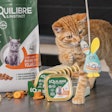US dog owners are most likely to received petfood recommendations from their veterinarians, followed by a friend or family member, then a pet store, according to the GfK PetInsights Study. While this is not a surprise, the study, presented on April 9 during Petfood Forum Asia 2014 by Pushan Tagore, director of pet nutrition services for GfK's Animal Health division, revealed some interesting insights on who and what influences the petfood purchasing decisions for US pet owners.
The study was conducted in spring 2013, reflecting petfood purchases from 2012, and involved 2,345 US dog and cat owners. GfK repeated the study this spring with dog owners only, reflecting the 2013 petfood purchases of 1,331 US dog owners; Tagore focused his presentation on the combined 2012 and 2013 dog owner responses. They had answered questions that helped GfK determine the incidence of petfood recommendations, the share of recommendations individual brands received, pet owner compliance with recommendations and the loyalty to brands based on recommendations.
GfK found that 29.3% of US dog owners received petfood recommendations in 2012; that increased to 32.6% in 2013. Looking at recommendations by source, 14.8% came from veterinary clinics in 2012 and 15.8% from the same source in 2013 (about 39% of all recommendations received). Friends or family members checked in at 9% and 10.4% in 2012 and 2013, respectively, followed by pet stores at 9.7% and 10.8%. The next source of petfood recommendations, online sources, dropped to 3.9% and 5.3% in 2012 and 2013, respectively.
Though breeders had a low incidence of providing petfood recommendations (1.8% in 2012 and 2.1% in 2013), their recommendations carried a lot of weight, with 84% (in 2012) to 86% (2013) of dog owners following those recommendations. Veterinary recommendations also had high compliance, at 77% to 80%, while pet store recommendations garnered 68% to 69% compliance. Online sources lagged at 57% to 58% compliance.
GfK even looked at the type of pet stores giving petfood recommendations and how well dog owners complied: Pet specialty stores (independent pet shops) received the highest compliance, at 77%, while PetSmart recommendations received 70% compliance and Petco, 63%. Recommendations from regional pet store chains were followed only 52% of the time.
No surprises there. Yet when GfK delved into the type of online sources from which dog owners received and followed petfood recommendations, things got interesting. "Information websites," which Tagore defined as ones not allied with any particular petfood manufacturer and intended solely to inform (he gave DogFoodAdvisor.com as an example), received the highest compliance, at 68%, followed by manufacturer websites at 66% -- which even beat social media at only 59% compliance.
Most of us in the petfood industry probably groan to see a site like DogFoodAdvisor.com being followed when it comes to petfood recommendations; but if pet owners are going to follow online sources (which, perhaps fortunately, they do only about 58% of the time), it's not a surprise to see sites like that having influence. The shocker comes from manufacturer websites having more influence than social media -- even though family and friends rank higher as influencers when it comes to petfood recommendations.
A Petfood Forum Asia audience member asked Tagore if that lower influence from social media reflected the demographics of the study respondents, which skewed somewhat older (36% were 50-59 years old) and reflected a 69% rate of marriage. Tagore responded that this was one finding he would like to watch over time as GfK continues to administer the study each year, to see if that social media influence level changed. (He also said that his firm hopes to soon expand the study to markets outside the US.)
A few other study findings of note:
- The highest compliance came from verbal recommendations accompanied by a promotion (discount, buy one get one free, etc.)
- Breeders are most likely to recommend dry dog food (96% of brands recommended in 2012, 90% in 2013), though the incidence of raw food recommendations grew from only 2% in 2012 to 6% in 2013
- Six in 10 users of the most purchased petfood brands in 2012 considered themselves very loyal to their respective brands (Tagore declined to name any brands, citing confidentiality reasons)


















